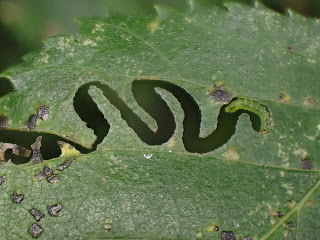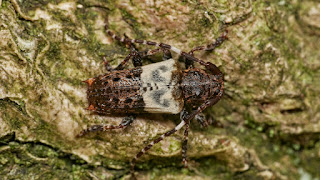Wednesday 21st September 2022, St. Mary, Caynham and St. Mary the Virgin, Bromfield
The Joy of Wildlife programme listed this outing as a visit to St. Mary’s Church in Caynham, but Caring for God’s Acre suggested that we might, in addition, like to visit the St. Mary the Virgin’s Church at Bromfield.
The visit to the church in Caynham attracted one of our larger gatherings of the year. And so keen was everyone that we were parked, booted, kitted up and ready to go by the meet time. A very rare occurrence!
 |
| Photograph: Bob Kemp |
Having taken this photograph of the church using his very long tripod, the photographer swivelled his camera around to take a photograph of the countryside between the church and a distant Titterstone Clee.
 |
| Photograph: Bob Kemp |
Returning to ground level here is the church as the rest of us saw it.
The church dates from the twelfth century but the nave and chancel were rebuilt in the 19th century retaining some of the earlier features. The cross standing in front of the church dates from the 14th century.
Unfortunately our arrival coincided with that of a huge tractor with hedge trimming equipment that proceeded to butcher cut the hedge for the next 60 minutes or so.
The churchyard was a mixture of grassland and various species of tree. Unfortunately the majority of the grass had been cut, but there were some more "neglected" areas around the church and gravestones.
Here are some of the insects we found:
A Box bug nymph;
 |
| Photograph: David Williams |
A ground beetle, Leistus spinibarbis which has been granted the rather quirky “common name” Prussian plate-jaw;
.jpg) |
| Photograph: David Williams |
A tiny Dot ladybird;
 |
| Photograph: David Williams |
A Ruby tiger moth larva;
 |
| Photograph: Nigel Cane-Honeysett |
A longhorn beetle, Pogonocherus hispidus;
And a larva of the Brimstone moth.
 |
| Photograph: David Williams |
Whilst we were there the day was fairly sunny and warm. We took full advantage of this as we camped out by the church wall and partook of lunch.
Unfortunately as lunch progressed the clouds built up and the sun disappeared, although it remained pleasantly warm and stayed dry.
Lunch over it was time to move on to our second church for the day, St Mary the Virgin, at Bromfield.
 |
| Photograph: Bob Kemp |
The origins of this church can be traced back to pre-Norman times. It was rebuilt in the 12th century and the tower added in the 13th.
After the dissolution of the monasteries parts of the church were incorporated into a private residence.
The house was damaged by fire in the 17th century, but some remains of the property can still be found.
The church was restored in the 19th century.
In its earliest days the church was associated with a priory. There did not seem to be any evidence of the priory now other than the gatehouse which sits at the corner of the churchyard.
However we were not there for a history lesson, interesting though it is, we were there to look around the churchyard.
 |
| Photograph: David Williams |
It was mainly grassland with trees being confined to the edges. Most of the grass was of medium length, but some areas of longer grass that remained uncut. There was only a small area that had been cut short.
At the rear of the church there was an avenue of yews. However it was rather dark and dingy so I was not tempted to take a look at where it led.
Did we find anything, you may be wondering?
Well, yes.
And here are some of the beasts we found:
A spider, Nigma walkenaeri;
 |
| Photograph: Nigel Cane-Honeysett |
A gall on yew caused by the gall midge Taxomyia taxi;
 |
| Photograph: John Lyden |
Another moth larva, this time a Scarlet tiger (with an attendant 16-spot ladybird);
 |
| Photograph: Nigel Cane-Honeysett |
A Bishop’s Mitre, perhaps an appropriate insect for a churchyard;
 |
| Photograph: David Williams |
And a sawfly larva munching its way through a leaf.
 |
| Photograph: John Lyden |
The sawfly is Apoceros leucopoda and is known as the Zig-zag sawfly, and seeing the pattern created by its feeding it is easy to see why.
Time to go home after an enjoyable day at these two churches.
I feel as though I have forgotten something …
I have forgotten something …
The title!
I have not said anything about a Dock bug, so what has it to do with the visits.
It is a quote from one of the group who uttered it to me after he had found a Dock bug in a Pine tree at St. Mary, Caynham.
As we drove home, the rhythm of “A Dock bug in a Pine tree” brought the “Twelve Days of Christmas” to mind. Can this quote become the start of a “Twelve Days of Joy of Wildlife” set to the same tune?
Two other lines came to mind immediately:
“3 Vacs a-vaccing”
“5 Madely Pit Mounds” (OK that does not have quite the same rhythm as the original but it is close enough.)
Can you supply any more?
My thanks to Caring for God’s Acre for arranging the visits and to the photographers for providing their excellent and varied images that illustrate the report.





.JPG)

.JPG)


.JPG)


.jpg)




.JPG)
.JPG)
.JPG)


%202022-09-23.jpg)




.jpg)
.JPG)
.JPG)

.JPG)






































